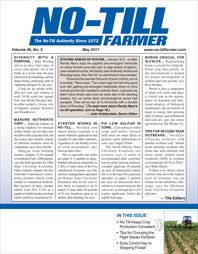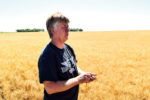Advertise Follow Us
No-Till Farmer

View Archived Issues
May 2017
Volume: 46
Edition: 5
Get full access NOW to the most comprehensive, powerful and easy-to-use online resource for no-tillage practices. Just one good idea will pay for your subscription hundreds of times over.
-
Table of Contents
Table of Contents
Digital Subscribers enjoy full access to No-Till Farmer's premium content. A paid subscription is required in order to read these stories.Are you a Premium or Digital subscriber? You enjoy:
- Unlimited access to all digital content here
- Freedom to view No-Till Farmer on all your devices
- Gleaning years of knowledge from the world's largest online library dedicated to no-till practices
Are you a Print only subscriber? Easily upgrade your subscription today! For only $10 more on a one year option, you gain the benefits of both the print edition delivered to your door and unlimited access to thousands of online pages of no-till content.
Selecting the Right Starter Fertilizer for Your No-Till Farm
The raw materials in a fertilizer product, its purity, salt index and what it’s being blended with all influence the availability of the nutrients and their impact on the crop.Read MoreWhat I've Learned from No-TillingNo-Till Lays Foundation for Consistent Crops, Rain or Shine
Financial challenges pushed Mike Belan’s family into conservation practices, but the Ontario no-tiller is focusing on improving soil health to propel the farm forward.Read More‘Flag the Technology’ to Keep Your Traits Straight, Profits Safe
An innocuous $4 flag, prudently placed, could help no-tillers avoid a failed crop or an irate neighbor due to a herbicide mistake.Read MoreEvening Out Emergence with a Strip-Till System
With 3,200 acres of hilly farmland susceptible to erosion, Kody Karloff’s transition to strip-till has helped create a flexible planting window and more consistent early-season crop health.Read MoreSeed Firmer Reads Organic Matter While You Plant
Precision Planting’s SmartFirmer combines seed firming with a high-resolution sensor to create soil maps on the go and variable-rate populations and hybrids based on organic matter.Read MoreSIMA 2017 Focuses on Future of Farming
International agribusiness show mixes technology and machinery innovations with theme of “Being a Farmer in 10 Years.”Read MoreUsing No-Till to Conquer Tough Field Conditions
Reducing soil disturbance and rotating crops and covers has reduced evaporation and helped the Neva family work through saline soils and other farming challenges.Read MoreEarly Control Key to Stopping Foxtail
A basic plan with pre-emergent herbicides should be enough to keep giant foxtail from dinging yields.Read More -
Featured Articles
Featured Articles
Early Control Key to Stopping Foxtail
A basic plan with pre-emergent herbicides should be enough to keep giant foxtail from dinging yields.Read MoreSelecting the Right Starter Fertilizer for Your No-Till Farm
The raw materials in a fertilizer product, its purity, salt index and what it’s being blended with all influence the availability of the nutrients and their impact on the crop.Read MoreWhat I've Learned from No-TillingNo-Till Lays Foundation for Consistent Crops, Rain or Shine
Financial challenges pushed Mike Belan’s family into conservation practices, but the Ontario no-tiller is focusing on improving soil health to propel the farm forward.Read More - Digital Edition
-
Online Extras
Online Extras








